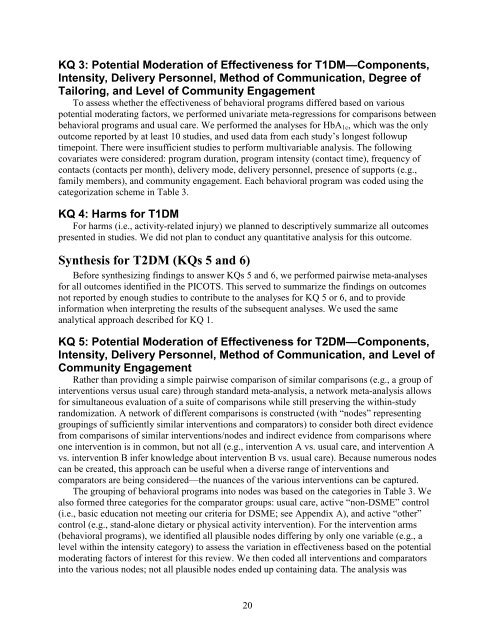Behavioral Programs for Diabetes Mellitus
diabetes-behavior-programs-report-150924
diabetes-behavior-programs-report-150924
- No tags were found...
Create successful ePaper yourself
Turn your PDF publications into a flip-book with our unique Google optimized e-Paper software.
KQ 3: Potential Moderation of Effectiveness <strong>for</strong> T1DM—Components,<br />
Intensity, Delivery Personnel, Method of Communication, Degree of<br />
Tailoring, and Level of Community Engagement<br />
To assess whether the effectiveness of behavioral programs differed based on various<br />
potential moderating factors, we per<strong>for</strong>med univariate meta-regressions <strong>for</strong> comparisons between<br />
behavioral programs and usual care. We per<strong>for</strong>med the analyses <strong>for</strong> HbA 1c , which was the only<br />
outcome reported by at least 10 studies, and used data from each study’s longest followup<br />
timepoint. There were insufficient studies to per<strong>for</strong>m multivariable analysis. The following<br />
covariates were considered: program duration, program intensity (contact time), frequency of<br />
contacts (contacts per month), delivery mode, delivery personnel, presence of supports (e.g.,<br />
family members), and community engagement. Each behavioral program was coded using the<br />
categorization scheme in Table 3.<br />
KQ 4: Harms <strong>for</strong> T1DM<br />
For harms (i.e., activity-related injury) we planned to descriptively summarize all outcomes<br />
presented in studies. We did not plan to conduct any quantitative analysis <strong>for</strong> this outcome.<br />
Synthesis <strong>for</strong> T2DM (KQs 5 and 6)<br />
Be<strong>for</strong>e synthesizing findings to answer KQs 5 and 6, we per<strong>for</strong>med pairwise meta-analyses<br />
<strong>for</strong> all outcomes identified in the PICOTS. This served to summarize the findings on outcomes<br />
not reported by enough studies to contribute to the analyses <strong>for</strong> KQ 5 or 6, and to provide<br />
in<strong>for</strong>mation when interpreting the results of the subsequent analyses. We used the same<br />
analytical approach described <strong>for</strong> KQ 1.<br />
KQ 5: Potential Moderation of Effectiveness <strong>for</strong> T2DM—Components,<br />
Intensity, Delivery Personnel, Method of Communication, and Level of<br />
Community Engagement<br />
Rather than providing a simple pairwise comparison of similar comparisons (e.g., a group of<br />
interventions versus usual care) through standard meta-analysis, a network meta-analysis allows<br />
<strong>for</strong> simultaneous evaluation of a suite of comparisons while still preserving the within-study<br />
randomization. A network of different comparisons is constructed (with “nodes” representing<br />
groupings of sufficiently similar interventions and comparators) to consider both direct evidence<br />
from comparisons of similar interventions/nodes and indirect evidence from comparisons where<br />
one intervention is in common, but not all (e.g., intervention A vs. usual care, and intervention A<br />
vs. intervention B infer knowledge about intervention B vs. usual care). Because numerous nodes<br />
can be created, this approach can be useful when a diverse range of interventions and<br />
comparators are being considered—the nuances of the various interventions can be captured.<br />
The grouping of behavioral programs into nodes was based on the categories in Table 3. We<br />
also <strong>for</strong>med three categories <strong>for</strong> the comparator groups: usual care, active “non-DSME” control<br />
(i.e., basic education not meeting our criteria <strong>for</strong> DSME; see Appendix A), and active “other”<br />
control (e.g., stand-alone dietary or physical activity intervention). For the intervention arms<br />
(behavioral programs), we identified all plausible nodes differing by only one variable (e.g., a<br />
level within the intensity category) to assess the variation in effectiveness based on the potential<br />
moderating factors of interest <strong>for</strong> this review. We then coded all interventions and comparators<br />
into the various nodes; not all plausible nodes ended up containing data. The analysis was<br />
20


